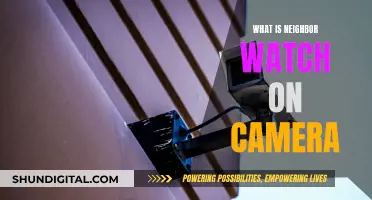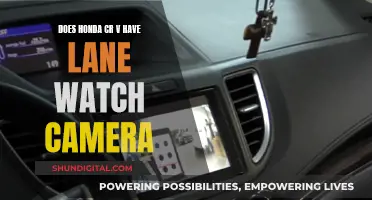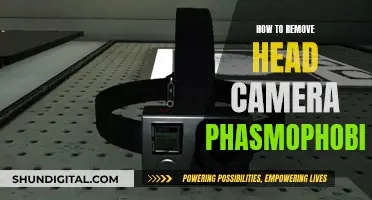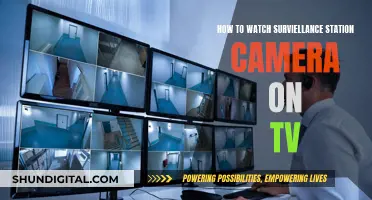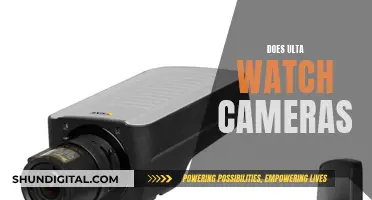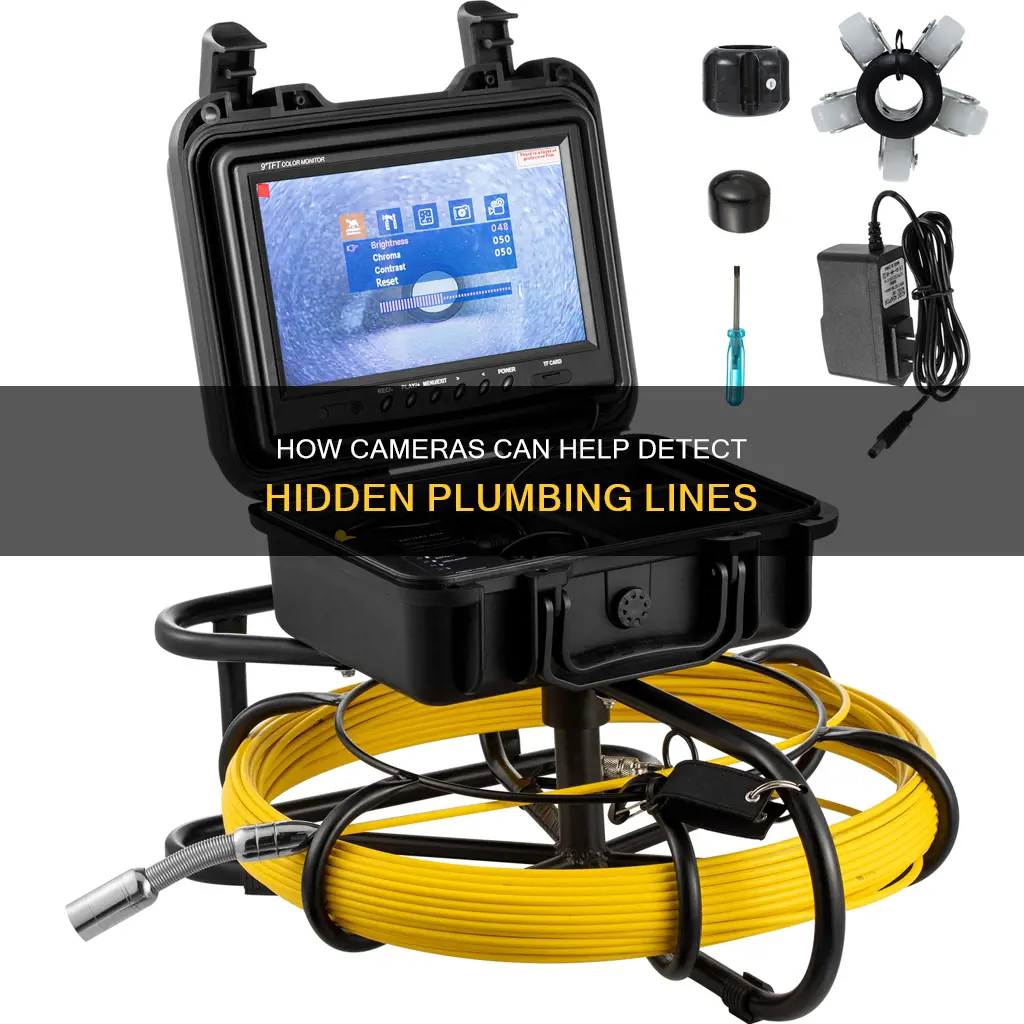
Plumbing issues can be a nightmare for any homeowner, but a camera inspection can help diagnose problems with speed and accuracy. A small, flexible camera attached to a cable is inserted into the pipes, allowing plumbers to see inside the pipes in real-time and identify any issues. This modern technology is a non-invasive way to get a visual of the plumbing system, saving time and money on plumbing inspections. While camera inspections are an excellent tool, they do have limitations. For example, they cannot determine if there is a leak in the pipes. However, they can identify blockages, tree roots, and other problems that may be causing plumbing issues. Overall, camera inspections are a valuable tool for homeowners to identify and address plumbing issues before they become more significant problems.
| Characteristics | Values |
|---|---|
| Camera Design | Waterproof, flexible, high-resolution |
| Camera Mount | Flexible rod/cable |
| Camera Use | Inspect interiors of plumbing lines and sewer pipes |
| Camera Benefits | Non-invasive, quick, accurate, cost-effective, records for future use |
| Camera Limitations | Cannot measure pipe size/material, requires access point, needs experienced operator |
What You'll Learn

Limitations of camera inspections
While camera inspections are a valuable tool for detecting issues in plumbing systems, it's important to note that they do have certain limitations. Here are some of the key limitations to be aware of:
Limited Visibility
Camera inspections are limited to areas within the pipes that are visible. If there are underground pipes or areas that are not easily accessible, potential issues in those areas may go undetected. This also means that external pipe damage cannot be detected.
Interpretation of Footage
The footage obtained from a sewer camera must be interpreted by a trained professional. Without proper experience and knowledge, potential issues may be missed or misinterpreted. The plumber viewing the monitor has to interpret what they are seeing and make an educated guess about the condition of the pipes.
Inability to Diagnose
Sewer cameras are designed to identify problems, not diagnose them. As a result, additional tests and inspections may be necessary to fully understand the issue and determine the most effective solution.
Tight Turns and Collapsed Sections
Drain cameras cannot navigate very tight turns or collapsed sections of pipes. These inaccessible areas may prevent the camera from reaching certain parts of the plumbing system.
Limited Visibility in Flooded Pipes
Heavy water flow in flooded pipes can obscure the visibility of drain cameras, making it difficult to inspect the pipe's interior in such conditions.
Access Points
Drain cameras require access points, such as drain openings or cleanouts, to insert the camera into the plumbing system. If there are no access points available, the camera inspection may not be possible.
Inability to Measure Exact Pipe Size and Material
Drain cameras cannot provide exact measurements of pipe size and material. Instead, plumbers must infer this information from visual clues within the pipes.
Small Cracks or Defects
Very small hairline cracks or defects may be missed by drain cameras. These minor issues may not be visible to the camera, especially if they are external to the pipes.
Experienced Operator Required
The operation and navigation of drain cameras require skill and experience. Proper navigation techniques and documentation skills are essential to ensure effective inspections and accurate results.
Shooting TV Shows: The Single-Camera Setup Secrets
You may want to see also

Benefits of camera inspections
Camera inspections are a valuable tool for plumbers to determine problems with your home's sewer system. They can be used to identify issues such as blockages, leaks, tree root intrusion, pipe corrosion, misalignments, and other structural damage within the pipes.
Non-Invasive
Camera inspections are non-invasive and can be performed without digging up pipes or breaking concrete. This means plumbers only need a small entry point to insert the camera, and there is no mess or damage to your property.
Quick and Accurate
Camera inspections are quick and accurate, allowing plumbers to identify the exact location of a problem. This helps to reduce costs and repair time, as well as preventing minor issues from becoming more significant problems.
Identify Blockages
Camera inspections can identify blockages in pipes that might otherwise be missed. If the blockage is not at the drain level, it can be challenging to locate without a camera. The inspection can determine if the blockage is caused by tree roots, debris, or other materials, allowing plumbers to choose the most appropriate clearing method.
Locate Breaks and Leaks
Camera inspections can quickly locate breaks and leaks in pipes, which could otherwise be difficult to find. This is especially important for leaks hidden behind walls or under the foundation of your home, which can cause significant damage if left untreated.
Protect Your Lawn
Before camera technology, the only way to find clogs or leaks was by digging up the lawn, destroying grass, shrubs, and trees. With camera inspections, there is no need to trench through your lawn, protecting your landscape and saving you time and money on repairs.
Save Money on Future Repairs
Camera inspections can help you save money on future repairs, especially when purchasing a new home. By inspecting the sewer system, you can identify potential problems that could cost thousands of dollars to fix if left undetected.
Provide Visual Evidence
Camera inspections provide visual evidence of the condition of your pipes, which can be useful for insurance purposes or when negotiating repairs with a seller during the home-buying process.
Disabling Vizio TV Cameras: A Step-by-Step Guide
You may want to see also

How camera inspections work
Camera inspections are a valuable tool to help determine if there is a problem with your plumbing. They are also useful for new home inspections, septic system inspections, and remodelling inspections.
A specially designed waterproof plumbing camera is mounted on a flexible rod or cable that can navigate through bends and turns in the pipe system. The camera is inserted into the main sewer line cleanout or the vent stack and snaked through the pipes. The flexibility of the rod or cable allows the camera to travel through pipes, accessing tough corners and overcoming obstacles like tight bends. The length of the tubing or cable can be adjusted to reach deep into the sewer system.
As the camera is manoeuvred through the pipes, it transmits live video to a digital monitor, allowing the technician to see the pipe in real-time. The technician uses the monitor to direct the camera and identify any faults in the pipeline. The video is also recorded for future reference and to provide visual evidence of problems to homeowners.
The camera can identify issues such as blockages, leaks, tree root intrusion, pipe corrosion, misalignments, and other structural damage within the pipes. It can also be used to locate lost items that have fallen down the drain and to verify pipe connections before repairs.
While camera inspections are a useful tool, they do have some limitations. They cannot identify leaks in pipes as the camera is inside the pipe and cannot see if something is leaking out. They also cannot measure the exact pipe size and material, and may miss some hairline cracks or defects.
Reality TV: Unveiling the Truth Behind the Cameras
You may want to see also

When to use a camera inspection
A camera inspection is a non-invasive, accurate, and cost-efficient way to identify plumbing issues. Here are some scenarios when using a camera inspection is beneficial:
Retrieving Lost Items:
If you accidentally drop a valuable or sentimental item down the drain, a camera inspection can help locate and retrieve it.
Inspecting Potential Homes:
When buying a new home, it is essential to ensure that the plumbing system is in good condition. A camera inspection can identify any existing or potential issues with the pipes before you finalise the purchase.
Septic System Issues:
Plumbing camera inspections can identify problems in your septic system before they escalate. This is especially useful if you notice signs such as low water pressure, slow drains, or frequent backups.
Remodeling:
If you're planning a bathroom or kitchen remodel, a camera inspection can determine whether your existing plumbing system can accommodate the changes you have in mind.
Preventative Maintenance:
Regular camera inspections, recommended every one to three years, can help identify potential issues before they become emergencies. This proactive approach can save you from costly repairs or replacements in the future.
Unexplained Plumbing Problems:
If you're experiencing persistent plumbing issues that can't be easily diagnosed, a camera inspection can provide an accurate picture of the problem. This will empower you to make informed decisions about repairs and maintenance.
Older Homes:
For houses over 20 years old, a camera inspection is highly recommended. Older plumbing systems are more prone to leaks, blockages, and other issues due to wear and tear.
In summary, camera inspections are a valuable tool for homeowners and plumbers alike, offering a non-invasive way to identify and address plumbing issues promptly and accurately.
Wiring Cameras: Viewing Every Angle on All TVs
You may want to see also

What camera inspections can be used to find
Camera inspections are a valuable tool for plumbers to determine whether there is a problem with a home's sewer system. They can also be used to identify the exact cause of plumbing issues, allowing plumbers to address problems non-invasively and develop strategies for repairs.
Camera inspections can be used to find:
- The source of clogs and backups: A camera can identify where a clog is located and what is causing it.
- Cracks, breaks, or pipe collapse: Small fractures or sinking pipes may be difficult to detect otherwise.
- Corrosion, mineral buildup, and other damage: Cameras allow for a close inspection of pipe interiors to check for these issues.
- Intruding roots: Tree roots that infiltrate and block pipes can be easily spotted with a camera.
- Pipe type: Plumbers can determine whether pipes are cast iron or PVC by running a camera inside them.
- Fittings, tees, and other types of connections: Camera inspections can be used to see fittings and connections, as well as to run water and observe its flow between lines.
- Lost items: A camera inspection can help retrieve valuable or sentimental items that have been lost down a drain.
While camera inspections are extremely useful, it is important to note that they have some limitations. For example, they cannot be used to determine if there is a leak in the sewer lines, as they cannot see the outside of the pipe. Additionally, they may not be able to access very tight turns or collapsed sections of pipes, and their view can be limited in flooded pipes.
Hisense TV: Camera and Microphone Features Explored
You may want to see also
Frequently asked questions
A sewer camera inspection is when a plumber uses a small, flexible camera attached to a cable to investigate plumbing issues. The camera is inserted into the main sewer line cleanout or vent stack and snaked through the pipes.
A sewer camera inspection can detect sewer problems such as blockages or backups caused by paper, grease, or other items blocking the line. It can also spot tree roots, which have different remedies than other types of blockages.
A sewer camera inspection cannot determine or locate a leak in your sewer lines. This is because the camera is inside the pipe and cannot see the outside of the pipe to detect if something is leaking out.
If you are experiencing plumbing issues such as a clogged drain, multiple plugged drains, or an odour, you may need to get a camera inspection to diagnose the problem. It is also recommended to get a sewer camera inspection when buying a new home to assess the plumbing.
A sewer camera inspection is a non-invasive way to get a visual of your plumbing system. It is also more cost-effective and quicker than traditional plumbing inspections, as it does not require digging up your yard or putting holes in your walls to find the problem.


